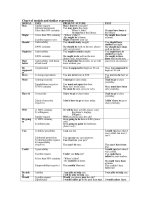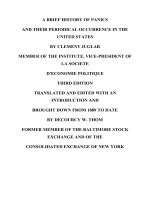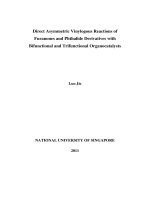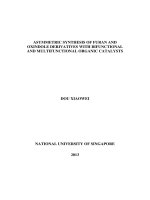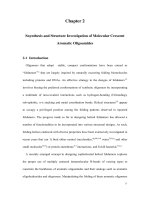Seasonal incidence of insect-pests of soybean and their correlation with abiotic factors
Bạn đang xem bản rút gọn của tài liệu. Xem và tải ngay bản đầy đủ của tài liệu tại đây (149.92 KB, 5 trang )
Int.J.Curr.Microbiol.App.Sci (2019) 8(4): 752-756
International Journal of Current Microbiology and Applied Sciences
ISSN: 2319-7706 Volume 8 Number 04 (2019)
Journal homepage:
Original Research Article
/>
Seasonal Incidence of Insect-pests of Soybean and their
Correlation with Abiotic Factors
Nikki Bhardwaj1*, Bhavna Verma2 and Praveen Bhardwaj1
1
2
Jagannath University, Jaipur (Raj), India
Dr. B.R. Ambedkar University of Social Science, Mhow (MP), India
*Corresponding author
ABSTRACT
Keywords
Weather factors,
blue beetle,
Tobacco caterpillar
and Correlation and
regression
Article Info
Accepted:
07 March 2019
Available Online:
10 April 2019
A field experiment was conducted during kharif crop season 2015-16 at college of
agriculture, Indore (M.P.) on cultivar RVS 2001-4 to assess the effect of weather factors
on the trend of blue beetle and tobacco caterpillar activities. The crop was sown in second
week of June, 2015-16 in an area of 200 (20x10m) square meters following the
recommended agronomical practices with the spacing of 40 x10 cm rows and plants,
respectively. The observations on the appearance of major insect pests were recorded from
germination to harvest of the crop at weekly intervals at 10 different sites in 1 meter row
length from each site once in a week and correlation was worked out. For blue beetle per
cent infestation and for tobacco caterpillar, larval population was counted. Blue beetle
infestation started in 26th MSW with 1.3% damage. The infestation increased and reached
its peak as 7.5 % in 32th SMW ending 31th August. After that the infestation decreased
slowly in next two weeks and noted least as 3.1% in 33 th SMW ending 7th September. The
occurrence of tobacco caterpillar started with 2.5% insects in 29 th SMW ending 10th
august. The population fluctuated and reached its peak as 14.5% in 35 th SMW ending 21st
September. Both the insects significant negative correlation with maximum temperature
(blue beetle, r = -0.667 and tobacco caterpillar, r = -0.528). Blue beetle significant positive
correlation with rain fall and rainy day (Rainfall r = 0.572 and Rainy day, r= 0.572) and
tobacco caterpillar significant positive correlation with morning humidity was recorded.
Rest of the abiotic factors exhibited non significant positive or negative correlation for
both insects.
grown on a variety of soil and in a wide range
of climate. Soybean is a kharif crop in India,
sown in June-July and harvested in late
September–October.
Introduction
Soybean (Glycine max (L.) Merril) is known
as the “Golden Bean” of the twentieth
century. It has emerged as an important
commercial crop in many countries and
international trade of soybean is spread
globally. Though soybean is a legume crop,
yet it is widely used as oilseed. It can be
Nationally soybean occupies an area of
108.39 lakh ha and its production is 114.83
lakh MT. Madhya Pradesh ranks first in total
area (54.09 lakh ha and 51.50%) and
752
Int.J.Curr.Microbiol.App.Sci (2019) 8(4): 752-756
production (59.170 lakh MT and 70.06%) in
the country and is known as “soya state” in
India (SOPA 2018).
and wind velocity were recorded as 27.140C,
21.570C, 92.14%, 282.4 mm, 5 days and 9.34
km/hr respectively.
The luxuriant crop growth, soft and succulent
foliage attracts many insects and provides
unlimited source of food, space and shelter.
More than 150 insect pests cause damage to
soybean in various parts of Madhya Pradesh
in different stages of crop, and damage due to
these insect-pests is one of major constrains
for soybean production. The incidence of blue
beetle and semilooper is a severe problem in
the region and causes maximum loss in
foliage and finally in yield. Global climatic
changes, has now compelled the scientific
community to study the effect of abiotic
factors on insect pests presence and their
trend of occurrence to manage them in
systematic manner. Viewing the above
situations the experiment was planned to
know the occurrence of blue beetle and
tobacco caterpillar relating with various
weather parameters.
Correlation studies
Correlation between population of blue
beetle, and weather factors i.e. temperature
(minimum and maximum), morning humidity,
rainfall, rainy days and wind velocity were
worked out. The „r‟ value of deferent
correlated factors expressed that (Table 2)
significant positive correlation was found
between rainfall (r=0.572), rainy days
(r=0.572), and non significant positive
correlation was noted with minimum
temperature (r= 0.031) and wind velocity (r=
0.445). The significant negative correlation
was observed with maximum temperature (r=0.667) and non significant negative
correlation with morning humidity (r=-0.060),
and population of blue beetle. It exhibited that
if the minimum temperature, morning
humidity, rainfall, rainy days and wind
velocity will increases or decreases from
mean value then the population of blue beetle
will also be increased or decreased
respectively.
Results and Discussion
Population dynamics of blue beetle in
soybean
Population dynamics of tobacco caterpillar
in soybean
The observations on blue beetle populations
were started from 26th SMW ending 29th June.
The insect population ranged from 1.3 to 7.5
during the season. The occurrence of insect
started with 1.3 insects in 26th SMW ending
29th June and it remained throughout the crop
growth, when the weather factor i.e.,
maximum
temperature,
minimum
temperature, humidity, rainfall, rainy days
and wind velocity were 32.570C, 23.860C,
88.57 %, 74.2 mm, 3 days and 9.34 km/h
respectively. The population fluctuated and
reached its peak as 7.5 insects in 32nd SMW
ending 10th August (Table 1) when the
maximum
temperature,
minimum
temperature, humidity, rainfall, rainy days
The observations on tobacco caterpillar
populations were started from 26th SMW
ending 29th June in Soybean. The pest
population ranged from 2.3 to 14.5 during 30th
to 38th SMW. The occurrence of insect started
with 7.2 insects in 30th SMW ending 27th
July and it remained throughout the crop
growth, when the weather factor i.e.,
maximum
temperature,
minimum
temperature, humidity, rainfall, rainy days
and wind velocity were 25.43 0C, 23.570C,
93.00 %, 170.1 mm, 6 days and 6.4 km/h
respectively. The population fluctuated (Table
1) and reached its peak as 14.5 insects in 35th
753
Int.J.Curr.Microbiol.App.Sci (2019) 8(4): 752-756
SMW ending 31st August when the maximum
temperature, minimum temperature, humidity,
rainfall, rainy days and wind velocity were
recorded as 31.29 0C, 23 0C, 91 %, 1 mm, 1
days and 6.63 km/hr respectively
Table.1 Seasonal incidence of major insect pests of soybean during kharif 2015-16
Period
SMW
Blue beetle population
23- 29 June
30t June-6 July
7-13 July
14-20July
21-27July
28July-3 Aug
4-10Aug
11-17 Aug
18-24 Aug
25-31Aug
1-7Sep
8-14Sep
15-21Sep
26
27
28
29
30
31
32
33
34
35
36
37
39
1.3
1.9
2.8
2.9
4.3
5.8
7.5
3.1
0.0
0.0
0.0
0.0
0.0
tobacco caterpillar
Population
0.0
0.0
0.0
5.0
7.2
9.3
6.4
5.8
8.5
14.5
7.6
3.8
2.3
Table.2 Correlation coefficient of blue beetle& tobacco caterpillar infestation with abiotic
factors in soybean
S.No.
Weather parameters
1
Temperature (0C)
Maximum
Minimum
Morning humidity (%)
Rainfall (mm)
Rainy day
Wind velocity (km/hr)
2
3
4
5
*
Correlation coefficient of
Blue beetle population
Correlation coefficient
of tobacco caterpillar
-0.6670
0.0313
-0.0608
0.5726
0.5724
0.4456
-0.5287
-0.3254
0.5147
0.0135
0.2763
-0.1839
Significant at 5% level
that (Table 2) significant negative correlation
(Table 2) was found with maximum
temperature (r= -0.606), and non significant
negative
correlation
with
minimum
temperature (r= -0.161) and wind velocity(r=
-0.198) while significant positive correlation
was found with morning humidity (r= 0.502)
and non significant positive correlation with
Correlation studies
Correlation between population of tobacco
caterpillar
and weather factors i.e.
temperature (minimum and maximum),
morning humidity, rainfall, rainy days and
wind velocity were worked out. The „ r ‟
value of deferent correlated factors expressed
754
Int.J.Curr.Microbiol.App.Sci (2019) 8(4): 752-756
rainfall(r= 0.210), and rainy days (r= 0.377).
Other weather factors exhibited non
significant impact on insect population. Shali
and Khadwe (2014) observed the appearance
of the tobacco caterpillar during last week of
july and disappeared during first week of
October. Ahirwar and Payal (2015) observed
the peak activity of green semilooper,
Chrysodeixis acuta; (0.7 larvae per meter
row) during second fortnight of August.
Yeotikar and More (2015) observed that the
green semiloooper recorded a peak of 3.00
larvae/mrl during 34th MW. Ahirwar and
Marabi (2014) recorded the peak larval
population of tobacco caterpillar (Chrysodexis
acuta) at 34th SW when maximum and
minimum temperature was 32°C and 28.2°C,
respectively. There was no significant
correlation exhibited between the larval
population and weather parameters. Yadav
and Banerjee (2015) observed that the
population of semilooper decreased with
increase in rainfall and RH. Yadav and
Agnihotri (2015) observed that maximum
level of Trichoplusi ni population attained
during 39thSW showed significant positive
correlation with minimum temperature and
evening relative humidity in black gram.
Kalyan and Ameta (2017) The maximum
incidence of tobacco caterpillar in soybean
crop was recorded during 41st SMW and
42nd SMW, respectively. The maximum
temperature and sun shine hours showed a
significant positive correlation with the larval
population of tobacco caterpillar while,
significant negative correlation with rainfall
during both the years. Whereas, maximum
temperature had significant positive impact on
population of tobacco caterpillar while
rainfall had significant negative effect.
respectively. Among the weather factors,
morning relative humidity showed significant
(r=0.954) and positively, highly influence on
the larval population per mrl whereas evening
humidity (r=-0.644) and sunshine hrs (r=0.367) negatively and significantly influence
the larval population per mrl. The various
weather parameters significantly caused 92
per cent variations in larval population per
mrl. The findings of these researchers are in
partial agreement as they did not study
completely similar to present investigation.
Further the climatic conditions vary place to
place which affect the activities of insect
pests.
References
Ahirwar, K.C., Marabi R.S and Bhowmick
A.K. (2014). Population dynamics of
major Insect Pests and seed yield of
Soybean. Ann. of Pl. Protec. Sci.,
22(1): 56-59.
Ahirwar, R., Devi P. and Gupta R. (2015).
Seasonal incidence of major insectpests and their biocontrol agents of
soybean crop (Glycine max L.
Merrill). Department of Entomology
IGKV, Raipur, 10(12): 402-406.
Kalyan, R.K. and Ameta O.P. (2017) Impact
of abiotic factors on seasonal
incidence of insect pests of soybean.
Legume Research An International J.
40(4) 762-767.
Ramesh babu, Prahlad Kumar Meena and
Ramgopal Dudwal (2017) Population
dynamics of major defoliators
(semiloopers and tobacco caterpillar)
in soybean crop. J. of Legume
Research, 40 (1) 2017: 183-186.
Shali Raju, G., Khandwe Nanda. and Nema
K.K. (2014). Seasonal incidence,
biology and behaviour of green
semilooper,
Chrysodeixis
acuta
(Walker) on Soybean. Ann. Of pl.
prote. Sci., 22(2): 306-309.
S. Ramesh babu et al., (2017) observed that
semilooper larval population was recorded
late July/early August and their peak activity
observed during 33-34, 33-36 and 37-39
standard weeks, in 2012, 2013 and 2014,
755
Int.J.Curr.Microbiol.App.Sci (2019) 8(4): 752-756
SOPA (2018). Estimates of area, productivity
& production of soybean in India and
MP. During Kharif. The soybean
processors association of India. PP.14.
Yadav, P., Banerjee S., Gupta M. P. and
Yadav V. K. (2015). Effect of
Weather
Factors
on
Seasonal
Incidence of Insect-Pests of Soybean.
J. of multidisciplinary advance
research, 4(1): 46-51.
Yadav, S.K., Agnihotri M. and Bisht R.S.
(2015). Seasonal incidence of insectpests of black gram, Vigna mungo
(Linn.) and its correlation with abiotic
factors. Agric.sci. digest., 35(2): 146148.
Yeotikar S.G., More D.G., Chav R.D. and
Gaikwad B.B. (2015). Correlation and
regression
between
weather
parameters and major insect pests of
soybean. Journal of Entomological
Research, 39(3): 227-230.
How to cite this article:
Nikki Bhardwaj, Bhavna Verma and Praveen Bhardwaj. 2019. Seasonal Incidence of Insectpests of Soybean and their Correlation with Abiotic Factors. Int.J.Curr.Microbiol.App.Sci.
8(04): 752-756. doi: />
756
